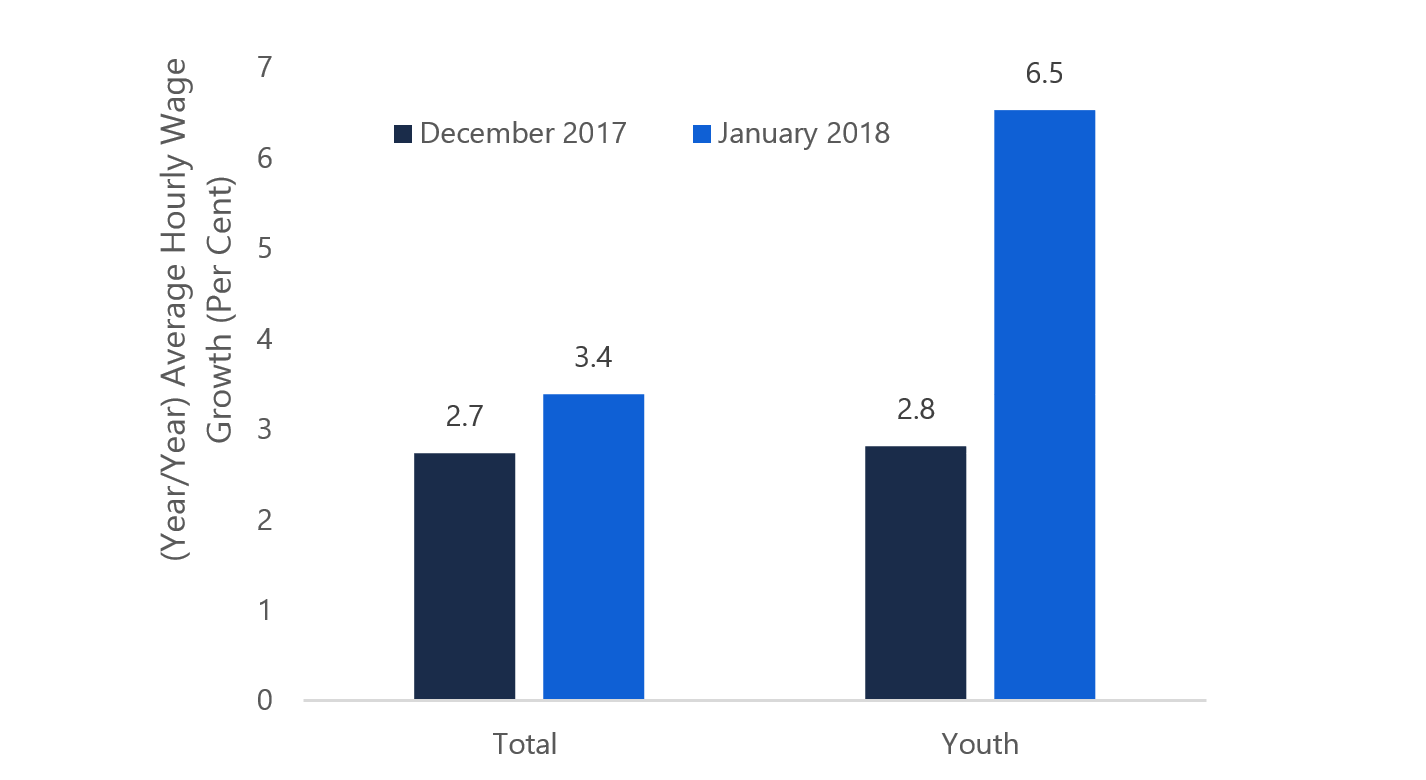The Ontario economy created 128,400 net new jobs in 2017, the largest annual job gain since 2003, while the unemployment rate dropped to 6.0 per cent, the lowest rate since 2000.[1]
The majority of the job gains last year were full-time, private sector positions. The service sector added 114,000 positions, accounting for 89 per cent of total job growth, while the goods sector added 14,500 new jobs, led by solid employment gains in manufacturing industries.
Strong Job Growth in 2017 Helps Lower Unemployment Rate Below Pre-Recession Levels
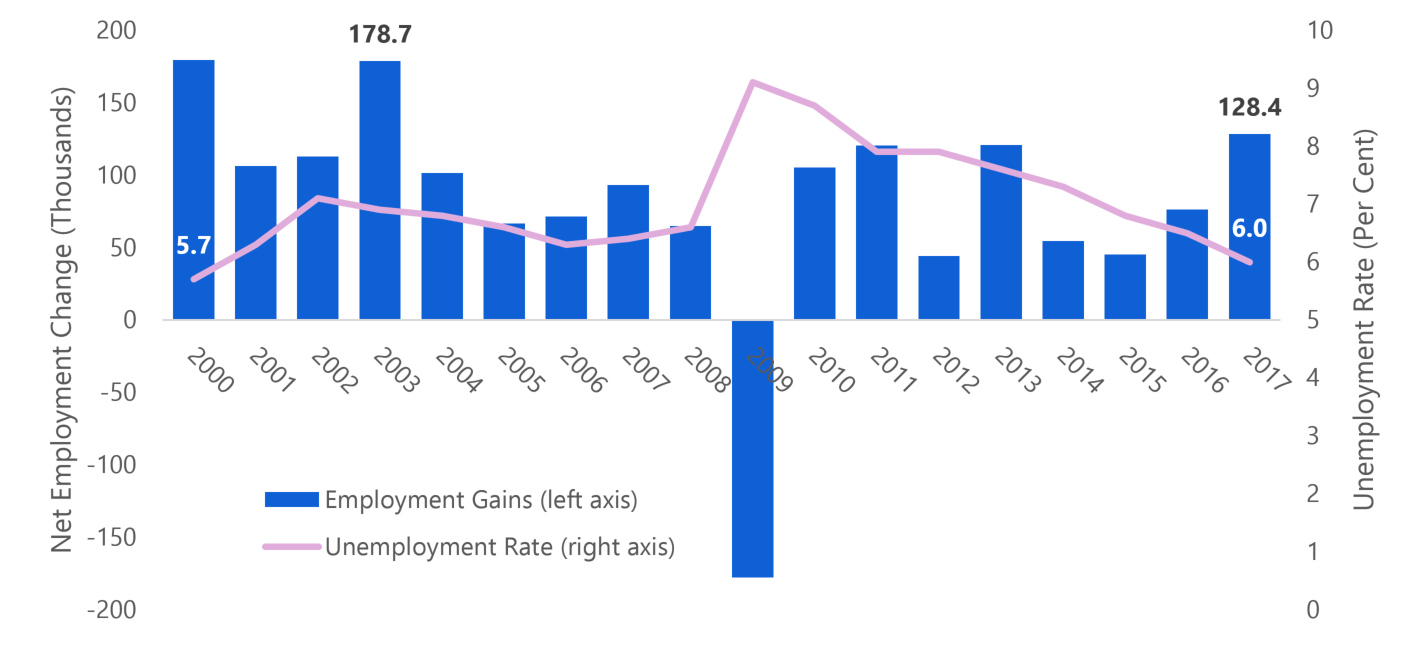
Source: Statistics Canada and FAO.
Strong Headline Results, as Labour Market Continues to Evolve
Looking behind the strong headline results reveals a changing labour market with both improvements for some workers, as well as continuing challenges for others.
- Despite broad-based employment gains in 2017, many labour market indicators such as the share of full-time and private sector employment have yet to recover to their pre-recession averages.
- The pace of job growth has been uneven across Ontario regions.[2] Job gains in 2017 were heavily concentrated in the GTA (+69,700 jobs) and Central Ontario (+57,200 jobs). Only 1,600 net new jobs were created in Southwestern, Eastern and Northern Ontario combined.
- The labour force participation rate of Ontario youth remains well-below its historical average.
- To some extent, this is a reflection of rising school enrollment rates combined with the decision by many students not to participate in the labour market. However, over the long-term, higher educational attainment should contribute to better labour market outcomes.
- Non-standard forms of employment – sometimes referred to as ‘precarious work’ – have become more common. The share of temporary workers and multiple job holders (relative to total employment) increased in 2017, continuing a rising trend since the late 1990s. The share of involuntary part-time workers (another common measure of precarious work) has declined since the recession, but remains above its pre-recession average.
- While the official unemployment rate sharply declined, the number of Ontarians experiencing long-term unemployment remains above the pre-recession level.
- Despite strong job gains and a steady decline in the unemployment rate, wages grew very slowly in 2017, continuing the trend of weak wage growth since the 2008-2009 recession.
- Labour Force Survey results for January 2018 provided a first look at the impact of Ontario’s minimum wage increase on average wages. While wages for some workers increased significantly and part-time employment declined, it is still too early to isolate the impact of the higher minimum wage, as monthly results can be very volatile.
- On average, women earned 87 cents for every dollar earned by men in 2017. The gender pay gap (the average hourly wage earned by women as a share of that earned by men) has not improved since 2011, and is present across all industries and the vast majority of occupational classifications.
Youth Labour Force Participation Declining as More Youth Stay in School
Despite posting a modest increase in 2017, the youth participation rate (the share of Ontarians aged 15 to 24 employed or looking for work) has been declining steadily since the early 1990s. The youth labour market includes both students (high-school and post-secondary) and non-students. The participation rates of both groups declined after the recession. However, while the participation rate of students has continued to decline, the participation rate of non-students has almost recovered to its pre-recession average. Since the 1990s, a rising youth enrollment rate in post-secondary education has increased the proportion of students among the youth population, which in turn has exerted downward pressure on the overall youth participation rate.[3]
Student Participation Rate Falls, Yet Non-Student Participation Approaches Pre-Recession Average

Source: Statistics Canada and FAO.
Declining labour market participation by students reflects both personal choice as well as labour market conditions. However, rising post-secondary enrollment should lead to stronger labour market outcomes in the long-term, since workers with higher educational attainment typically have higher wages and lower unemployment rates.
Limited Signs of Improvement for Precarious Workers
The term ‘precarious employment’ refers to different types of non-standard work, including part-time or temporary jobs, self-employment, or working multiple jobs. However, many people choose to work part-time, or are successfully self-employed. Focusing on the more clearly ‘precarious’ elements of employment - that is, involuntary part-time workers, temporary workers, and multiple job holders - reveals both good and bad news.
The share of people working involuntarily in part-time jobs (i.e. those who would rather have full-time work) has declined steadily in the past few years, falling to 5.1 per cent in 2017, but remains above the pre-recession average of 4.6 per cent.
Involuntary Part-Time Improving Slowly, But Share of Temp Work and Multiple Jobholders Still Rising

Source: Statistics Canada and FAO.
The number of temporary workers as a share of total employment increased to 11 per cent in 2017. This is essentially unchanged from the pre-recession high of 10.9 per cent in 2007, and is up significantly from the late 1990s. While temporary employment[4] may suit some workers, on average they earn 25 per cent less than permanent workers[5], are generally not eligible for employment benefits and experience much lower job security.
The proportion of workers with multiple jobs increased to 5.6 per cent in 2017, continuing a slowly rising trend since the late 1990s. The majority of multiple job-holders work more than 40 hours per week on average, while almost 40 per cent of multiple job-holders work 50 hours or more per week.[6]
Long-Term Unemployment Improving, But Remains Somewhat Elevated
Ontario’s overall unemployment rate declined to 6.0 per cent in 2017, the lowest rate since 2000. Despite this, the number of workers unemployed for longer than six months (the “long-term unemployed”) is improving more slowly, and remains above pre-recession levels. Of the 451,800 Ontarians unemployed in 2017, almost 90,000 were unemployed for longer than six months.
The slow pace of improvement in the number of long-term unemployed workers, despite strong job gains, suggests a skills mismatch between some unemployed workers and potential employers.[7]
Long-term Unemployment Declining Slowly
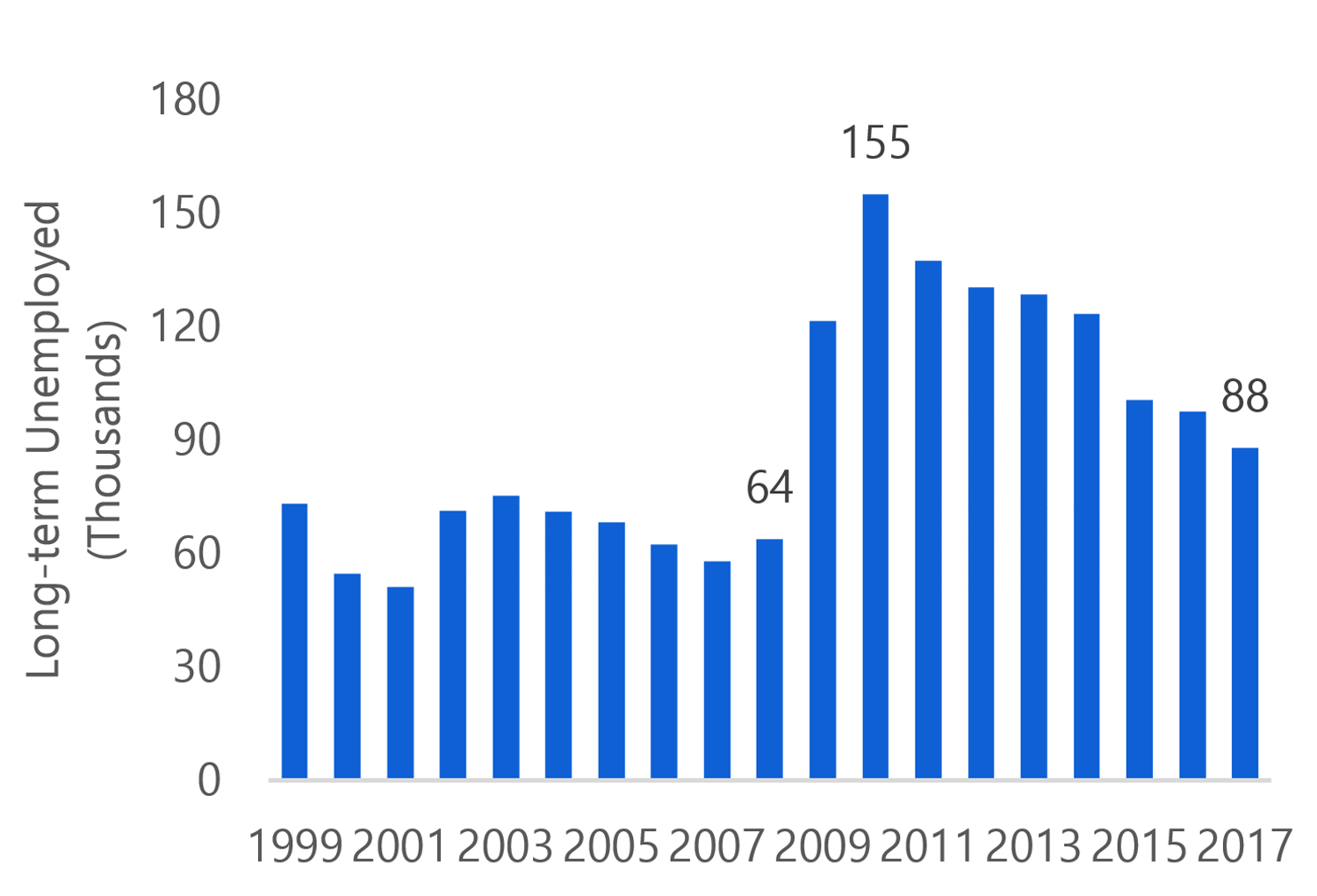
Source: Statistics Canada and FAO.
Hourly Wage Growth Has Been Sluggish Since Recession
Despite strong job gains and a sharp drop in the unemployment rate, average wages increased by only 1.1 per cent in 2017, the weakest gain since 1998. The weak pace of wage growth last year continues a trend of modest wage gains since the 2008-2009 recession.
Hourly Wage Growth Has Been Muted Since Recession
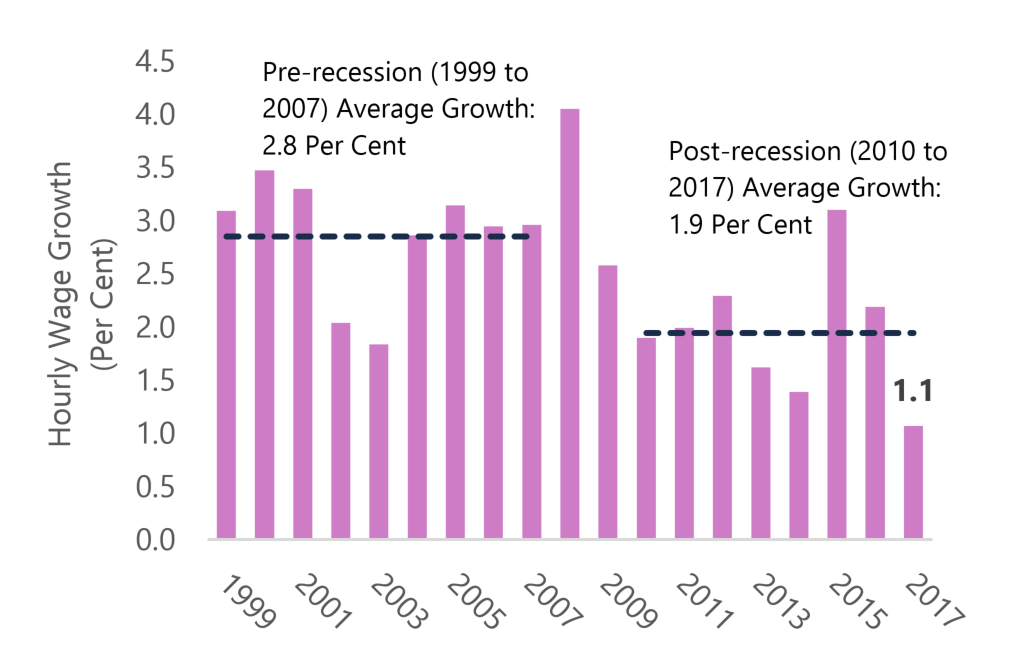
Source: Statistics Canada and FAO.
In real terms, after adjusting for consumer price inflation, wages declined by 0.6 per cent in 2017. The slow growth of wages is not unique to Ontario, as most developed economies have also experienced muted wage gains since the global recession.[8]
A First Look at the Impact of Ontario’s Minimum Wage Increase
On January 1, 2018, Ontario’s legislated minimum wage increased from $11.60 to $14.00 per hour. The Labour Force Survey results for January provide an early look at the initial effect of the higher minimum wage on overall wages in Ontario. However, an assessment of the impact of the minimum wage increase on employment will require many more months of data.[9]
|
Hourly Wage Growth for Youth Jumps in January 2018
Source Statistics Canada and FAO. |
In January 2018, total employment fell by 51,000 positions compared to December (on a seasonally adjusted basis), with a drop in youth employment accounting for roughly half of the overall decline. Total part-time employment fell by 59,000 jobs in January, more than offsetting a small gain in full-time employment.
Average hourly wages for Ontario workers increased by 3.4 per cent in January 2018, from a year earlier.[10] Youth workers (who are more likely to be paid the minimum wage) received a 6.5 per cent increase in wages in January, compared with a year ago.
Monthly labour force survey results can be very volatile and reflect many factors, including normal statistical variation. As a result, it is not possible to isolate the extent to which the minimum wage increase contributed to January’s monthly results.[11]
Ontario’s Gender Pay Gap Did Not Improve in 2017
In 2017, women earned 87 cents for every dollar in hourly wages earned by men, on average.[12] Since 1997, the average hourly wage rate of women grew 0.3 percentage points faster than the equivalent average wage rate for men, moderately narrowing the gender pay gap. However, since 2011, the gender pay gap has been roughly unchanged.
Gender Pay Gap Persists, Economy-Wide
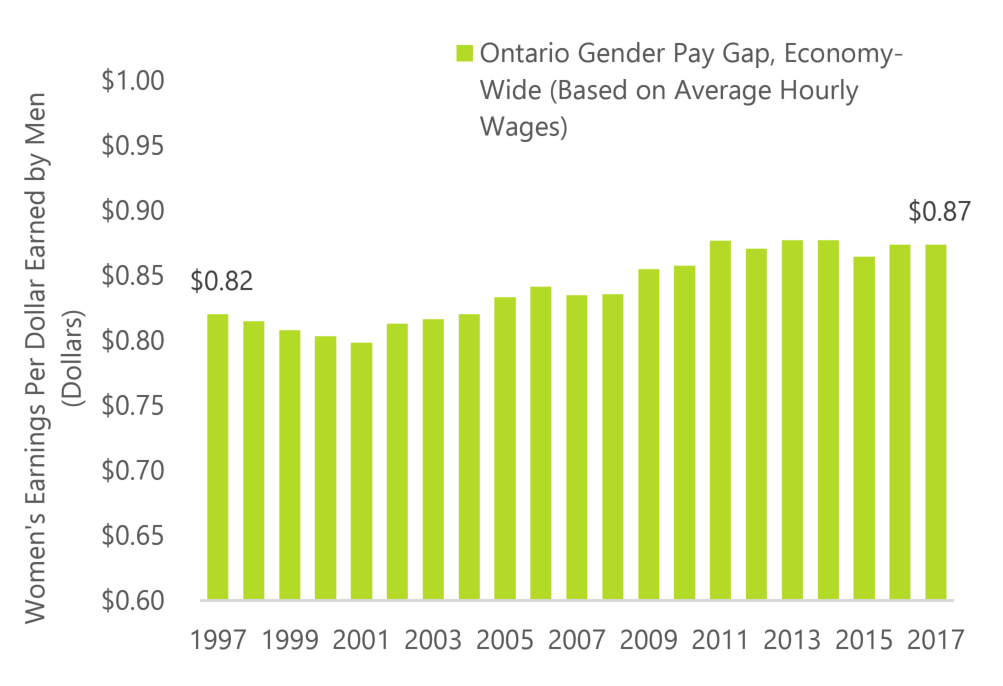
Source: Statistics Canada and FAO.
Gender pay gaps are present across all industries and the vast majority of occupational classifications.[13] According to Statistics Canada, if all Canadian men and women received equal hourly pay in each occupation classification, the average gender pay gap would be largely eliminated.[14]
While the different distribution of men and women across occupations accounts for some of the gender pay gap, the majority of the gap is due to other factors.[15]
Nicolas Rhodes
Economist
nrhodes@fao-on.org
Edward Crummey
Director
ecrummey@fao-on.org
David West
Chief Economist
dwest@fao-on.org
Financial Accountability Office of Ontario
2 Bloor Street West, Suite 900
Toronto, Ontario M4W 3E2
Media queries, contact: Kismet Baun, 416.254.9232 or email kbaun@fao-on.org.
About the FAO
Established by the Financial Accountability Officer Act, 2013, the Financial Accountability Office (FAO) provides independent analysis on the state of the Province’s finances, trends in the provincial economy and related matters important to the Legislative Assembly of Ontario. Visit our website at http://www.fao-on.org/en/ and follow us on Twitter at https://twitter.com/InfoFAO.
[1] Unless otherwise indicated, this commentary reports labour market results based on Labour Force Survey annual values.
[2] The regions include: the Greater Toronto Area, Southwestern Ontario (Windsor, London and Stratford areas), Central Ontario (Kitchener, Waterloo, Barrie, Hamilton, Niagara, Muskoka and Kawarthas areas), Eastern Ontario (Ottawa, Kingston and Pembroke areas) and Northern Ontario (Sudbury and Thunder Bay areas).
[3] Statistics Canada, CANSIM Table 477-0033.
[4] Temporary employment includes seasonal jobs, term or contract jobs (including work done through a temp agency), casual jobs, and other temporary work.
[5] Statistics Canada, CANSIM Table 282-0074.
[6] Statistics Canada, CANSIM Table 282-0036.
[7] Since the recession, unemployment levels have declined while the size of the labour force has increased. Long-term unemployment as a share of the labour force was only 0.2 percentage points above its pre-recessionary average in 2017.
[8] International Monetary Fund, World Economic Outlook, October 2017, Chapter 2.
[9] See the FAO’s Assessing the Economic Impact of Ontario's Proposed Minimum Wage Increase for a discussion of the economic impacts of Ontario’s minimum wage increases.
[10] The minimum wage rate was $11.40 in January of 2017.
[11] As with all statistical surveys, Statistics Canada’s Labour Force Survey estimates are subject to normal statistical variation. The standard error of the monthly change in Ontario employment is +/- 19,600.
[12] This measure is calculated by dividing the aggregate average hourly wage earned by women by the aggregate average hourly wage earned by men. This ratio only accounts for hourly wage earnings as reported in the Labour Force Survey and does not include other forms of income. Average hourly wages controls for the different number of hours worked by men and women.
[13] For wage by industry, see Statistics Canada’s CANSIM Table 282-0072, for wages by occupation classification, see Statistics Canada’s CANSIM Table 282-0152.
[14] Statistics Canada estimates that if women were paid the same wage rate as men within each occupation classification, the average gender pay gap in Canada would improve from $0.87 to near equality at $0.97. See Women and Paid Work, Melissa Moyser, Statistics Canada, March 2017.
[15] For a detailed discussion of the gender pay gap in Canada, refer to Women and Paid Work, Melissa Moyser, Statistics Canada, March 2017.
Strong Job Growth in 2017 Helps Lower Unemployment Rate Below Pre-Recession Levels
This graph shows Ontario’s net employment change and unemployment rate from 2000 to 2017. Employment grew in 2017 by +128,400 positions, the largest increase in jobs since 2003. The graph shows the unemployment rate declining since 2009, falling from 9.1 per cent in 2009 to 6.0 per cent in 2017.
Student Participation Rate Falls, Yet Non-Student Participation Approaches Pre-Recession Average
This group of three charts shows three sets of youth participation rates from 1976 to 2017: the overall youth participation rate, the non-student participation rate and the student participation rate. The overall youth participation rate has been declining since the early 1990s. The non-student participation rate fell during the recession, but has since increased to 86.4 per cent, and is approaching its pre-recession average of 87.2 per cent. The student participation rate also fell during the recession and has continued to decline. In 2017 it dropped further to 40.9 per cent, well below its pre-recession average of 48.0 per cent.
Involuntary Part-Time Improving Slowly, But Share of Temp Work and Multiple Jobholders Still Rising
This group of three charts shows three aspects of precarious work: involuntary part-time workers, temporary workers and multiple jobholders, all as a share of total employment from 1997 to 2017. The share of involuntary part-time workers spiked during the recession, but has since fallen to 5.1 per cent in 2017, still above its pre-recession average of 4.6 per cent. The share of temporary workers has been increasing since 1997. In 2007 the share was 10.9 per cent. Since 2007 the share has changed little, increasing to 11.0 per cent in 2017. The share of multiple job holders has also been increasing since 1997. In 2007 the share was 5.4 per cent. Since 2007 the share has slowly increased reaching 5.6 per cent in 2017.
Long-term Unemployment Declining Slowly
This chart shows the level of long-term unemployed in thousands from 1999 to 2017. The level was relatively steady from 1999 to 2007. During the recession the share increased rapidly, growing from 64 thousand people in 2007 to 155 thousand people in 2010. The number of long-term unemployed has since declined, reaching 88 thousand people in 2017, although it still remains above pre-recession levels.
Hourly Wage Growth Has Been Muted Since Recession
This chart shows average annual hourly wage growth 1999 to 2017. Pre-recession average annual wage growth was 2.8 per cent from 1999 to 2007. Following the recession, wage growth averaged 1.9 per cent from 2010 to 2017. In 2017, wage growth was 1.1 per cent, the weakest wage growth since 1998.
Hourly Wage Growth for Youth Jumps in January 2018
This chart shows the December 2017 and January 2018 year-over-year growth in average hourly wages for both total average hourly wages and youth average hourly wages. The chart shows that total year-over-year hourly wages increased from 2.7 per cent in December 2017 to 3.4 per cent in January 2018. Youth year-over-year hourly wages increased from 2.8 per cent in December 2017 to 6.5 per cent in January 2018.
Gender Pay Gap Persists, Economy-Wide
This chart shows the gender pay gap, women’s earnings per dollar earned by men, from 1997 to 2017, calculated using economy-wide average hourly wages. The chart shows that the gender pay gap improved from $0.82 in 1997 to $0.87 in 2017, although the gap hasn’t improved since 2011.






